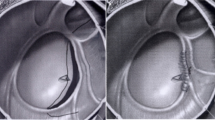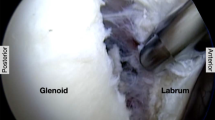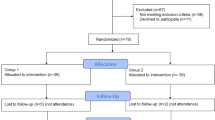Abstract
The aim of this study was to compare the clinical and radiographic results in patients with recurrent unidirectional, post-traumatic shoulder instability (dislocations/subluxations). All the patients had a Bankart lesion and underwent reconstruction using either an open or an arthroscopic technique and absorbable implants. Thirty-three consecutive patients (36 shoulders) were operated on by one surgeon. Group A comprised 18 shoulders which underwent an open Bankart reconstruction using absorbable 3.7-mm TAG suture anchors. Group B comprised 18 shoulders which underwent a combination of an intra- and extra-articular arthroscopic stabilization using 8-mm Suretac fixators. The median number of dislocations before the reconstruction was 5 (0–45) in group A and 4 (0–30) in group B (NS). The follow-up examination was performed by an independent observer after a median of 31 (range 25–38) months in group A and 28 (range 18–46) months in group B (NS). An independent radiologist without any knowledge of the surgical procedure evaluated all the radiographs. There were no re-dislocations in either group. In group A, the Rowe and Constant scores were 86 (range 61–98) and 89 (range 73–99), respectively. The corresponding values in group B were 92 (range 83– 98; P = 0.05) and 96 (range 75– 100; NS). The external rotation in abduction was 65° (range 20°–90°) in group A and 83° (range 65°–105°) in group B (P = 0.0017). The radiographs revealed that 10/18 (56%) in group A and 4/18 (23%) in group B had visible drill-holes or cystic formations in conjunction with the drill-holes (P = 0.002). In this study the open procedure resulted in a restriction in external rotation more frequently than the arthroscopic procedure. The radiographs revealed visible drill-holes or cystic formations in conjunction with the drill-holes more frequently when TAG suture anchors were used than when Suretac fixators were used. The radiographic changes did, not appear to affect the clinical outcome, however.
Similar content being viewed by others
Author information
Authors and Affiliations
Additional information
Received: 27 September 1997 Accepted: 22 January 1998
Rights and permissions
About this article
Cite this article
Kartus, J., Ejerhed, L., Funck, E. et al. Arthroscopic and open shoulder stabilization using absorbable implants A clinical and radiographic comparison of two methods. Knee Surgery 6, 181–188 (1998). https://doi.org/10.1007/s001670050096
Issue Date:
DOI: https://doi.org/10.1007/s001670050096




